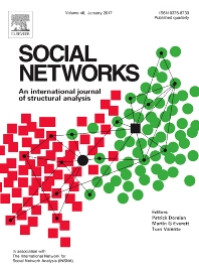
The article "Cluster analysis of multiplex networks: Defining composite network measures" by András Vörös and Tom Snijders has been published in Social Networks and is available online at:
http://www.sciencedirect.com/science/article/pii/S0378873315301209
http://dx.doi.org/10.1016/j.socnet.2017.01.002
Abstract
Social relations are multiplex by nature: actors in a group are tied together by various types of relationships. To understand and explain group processes it is, therefore, important to study multiple social networks simultaneously in a given group. However, with multiplexity the complexity of data also increases. Although some multivariate network methods (e.g. Exponential Random Graph Models, Stochastic Actor-oriented Models) allow to jointly analyze multiple networks, modeling becomes complicated when it focuses on more than a few (2–4) network dimensions. In such cases, dimension reduction methods are called for to obtain a manageable set of variables. Drawing on existing statistical methods and measures, we propose a procedure to reduce the dimensions of multiplex network data measured in multiple groups. We achieve this by clustering the networks using their pairwise similarities, and constructing composite network measures as combinations of the networks in each resulting cluster. The procedure is demonstrated on a dataset of 21 interpersonal network dimensions in 18 Hungarian high-school classrooms. The results indicate that the network items organize into three well-interpretable clusters: positive, negative, and social role attributions. We show that the composite networks defined on these three relationship groups overlap but do not fully coincide with the network measures most often used in adolescent research, such as friendship and dislike.
Keywords: Multiplex networks; Multilayer networks; Dimension reduction; Cluster analysis; Peer perceptions; Adolescents

